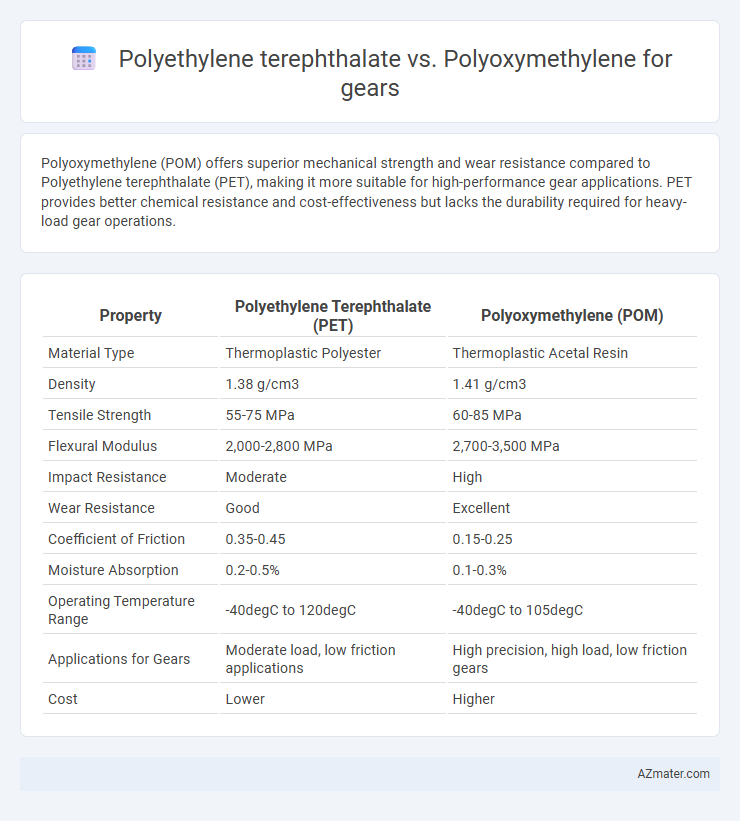Polyoxymethylene (POM) offers superior mechanical strength and wear resistance compared to Polyethylene terephthalate (PET), making it more suitable for high-performance gear applications. PET provides better chemical resistance and cost-effectiveness but lacks the durability required for heavy-load gear operations.
Table of Comparison
| Property | Polyethylene Terephthalate (PET) | Polyoxymethylene (POM) |
|---|---|---|
| Material Type | Thermoplastic Polyester | Thermoplastic Acetal Resin |
| Density | 1.38 g/cm3 | 1.41 g/cm3 |
| Tensile Strength | 55-75 MPa | 60-85 MPa |
| Flexural Modulus | 2,000-2,800 MPa | 2,700-3,500 MPa |
| Impact Resistance | Moderate | High |
| Wear Resistance | Good | Excellent |
| Coefficient of Friction | 0.35-0.45 | 0.15-0.25 |
| Moisture Absorption | 0.2-0.5% | 0.1-0.3% |
| Operating Temperature Range | -40degC to 120degC | -40degC to 105degC |
| Applications for Gears | Moderate load, low friction applications | High precision, high load, low friction gears |
| Cost | Lower | Higher |
Introduction to Engineering Plastics for Gears
Polyethylene terephthalate (PET) and polyoxymethylene (POM) are widely used engineering plastics for gears due to their distinct mechanical properties and thermal stability. PET offers excellent dimensional stability and chemical resistance, making it suitable for high-load applications requiring durability and wear resistance. POM, known for its superior stiffness, low friction, and high fatigue resistance, is ideal for precision gears operating under dynamic stresses with reduced noise and wear.
Overview of Polyethylene Terephthalate (PET)
Polyethylene Terephthalate (PET) is a thermoplastic polymer renowned for its excellent mechanical strength, chemical resistance, and dimensional stability, making it suitable for gear manufacturing. PET offers high wear resistance and low friction properties, contributing to smooth gear operation and extended component lifespan. Its ability to withstand moderate temperatures and resist moisture absorption enhances performance in various industrial applications compared to other polymers like Polyoxymethylene (POM).
Key Properties of Polyoxymethylene (POM)
Polyoxymethylene (POM), also known as acetal, exhibits high stiffness, excellent dimensional stability, and superior wear resistance, making it ideal for precision gear applications. Its low friction coefficient and outstanding mechanical strength outperform polyethylene terephthalate (PET) in terms of durability and load-bearing capacity. POM's resistance to fatigue and chemical exposure ensures reliable long-term performance in demanding environments.
Mechanical Strength Comparison: PET vs POM
Polyoxymethylene (POM) exhibits superior mechanical strength compared to Polyethylene terephthalate (PET) when used in gear applications, offering higher tensile strength and better resistance to fatigue and wear. POM's enhanced stiffness and dimensional stability under load make it more suitable for high-stress environments requiring precise gear operation. While PET provides good chemical resistance and moderate mechanical properties, POM dominates in performance-critical gear manufacturing due to its excellent durability and low friction characteristics.
Wear Resistance and Durability in Gear Applications
Polyoxymethylene (POM) outperforms Polyethylene terephthalate (PET) in wear resistance due to its high crystallinity and low coefficient of friction, making it ideal for high-load gear applications. PET offers moderate durability but tends to have lower fatigue resistance compared to POM, which limits its use in continuous or high-stress environments. The superior mechanical strength and dimensional stability of POM result in longer gear lifespan and reduced maintenance requirements.
Chemical and Thermal Stability Analysis
Polyethylene terephthalate (PET) offers excellent chemical resistance to solvents, oils, and greases, maintaining structural integrity under moderate thermal conditions up to 120degC, making it suitable for gears exposed to mild environments. Polyoxymethylene (POM), or acetal, exhibits superior thermal stability with a melting point around 175degC and exceptional resistance to hydrocarbons, fuels, and alcohols, ensuring reliable gear performance in higher temperature and chemically aggressive conditions. The choice between PET and POM for gear applications hinges on the specific chemical exposure and operating temperature requirements, where POM provides enhanced durability in demanding thermal and chemical environments.
Machinability and Fabrication Differences
Polyethylene terephthalate (PET) offers good machinability with excellent dimensional stability, allowing for precise fabrication and smooth surface finishes in gear manufacturing. Polyoxymethylene (POM), or acetal, exhibits superior machinability due to its high stiffness, low friction, and ease of cutting, resulting in faster machining speeds and better tool life during gear production. PET gears are typically molded or machined with moderate ease, while POM gears benefit from enhanced fabrication efficiency and wear resistance, making POM the preferred choice for high-performance precision gears.
Cost-Effectiveness and Availability
Polyethylene terephthalate (PET) offers cost-effectiveness with its lower raw material price and widespread availability, making it a popular choice for gears in consumer applications. Polyoxymethylene (POM), while more expensive, provides superior mechanical properties and wear resistance, often justifying higher costs in high-performance gear systems. Availability of PET is generally higher globally due to extensive use in packaging, whereas POM production is more specialized, impacting lead times and pricing.
Environmental Impact and Recyclability
Polyethylene terephthalate (PET) offers superior recyclability compared to Polyoxymethylene (POM), as PET is widely accepted in municipal recycling programs and can be reprocessed multiple times without significant degradation. PET's environmental impact is lower due to its ability to be recycled into fibers, containers, and new plastic components, reducing landfill waste and raw material consumption. In contrast, POM's chemical structure makes it less amenable to mechanical recycling, often resulting in limited recycling options and higher environmental persistence.
Conclusion: Choosing the Best Material for Gear Performance
Polyoxymethylene (POM) offers superior wear resistance, low friction, and dimensional stability, making it ideal for high-performance gear applications requiring durability and precision. Polyethylene terephthalate (PET) provides good chemical resistance and stiffness but generally lacks the mechanical strength and fatigue resistance of POM in demanding gear environments. Selecting POM ensures enhanced gear longevity and efficiency, especially in applications involving continuous operation and significant mechanical stress.

Infographic: Polyethylene terephthalate vs Polyoxymethylene for Gear
 azmater.com
azmater.com